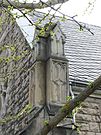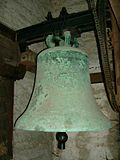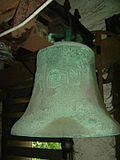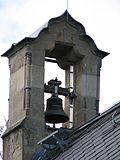Kreuzkirche (Weimar)
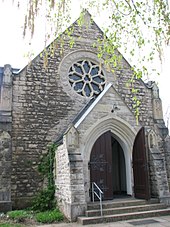
The Evangelical Lutheran Kreuzkirche in Weimar has been part of the local Evangelical Lutheran parish since 1928 , and a parish of the Evangelical Church in Central Germany since 2009 . The sacred building was originally consecrated in 1899 as the Church of England's Saint Michael and all Angels Church .
architecture
The Kreuzkirche is a neo-Gothic hall church of low proportions. It was built in 1899 by Rudolf Zapfe for the Anglican parish in Weimar. In terms of the style and proportions of the exterior, Zapfe oriented itself towards the type of a small English church from the early Gothic period in the interests of its clients.
The exterior of the nave has been preserved from its original condition; the interior was redesigned by architect Klaus Kaufmann and sculptor Friedrich Press after the eventful building fate of 1973–1974 .
History and present
Since the middle of the 19th century, a large number of people, mostly of English origin, who felt closely connected to the city, the German language, German culture and Weimar Classics , became at home in Weimar . These scientists, artists and cultural workers and their families were able to realize their wish in 1899 and build their own church for their parish on the outskirts of Weimar. The church was consecrated on September 29, 1899 and was named Saint Michael and all Angels . It was built in the perpendicular style ; another source classifies it as a neo-Gothic building .
With the beginning of the First World War in 1914, these people were classified as Germany's opponents of the war and had to leave Weimar and Germany. The sacred building was orphaned and remained unused for many years. Finally, Weimar's Evangelical Lutheran parish acquired the building and rededicated it on September 30, 1928 as the “Kreuzkirche”. At this time, the Rabitz ceiling , arched in several segments , was also installed under the roof structure that had been visible until then.
In 1955, master organ builder Gerhard Kirchner installed his organ (renewed in 1989), and in 1962 the Schilling bells from Apolda were installed in the bell tower adjoining the church building.
During a thorough renovation between 1972 and 1975, the interior got a different shape. The Eisenach church builder and architect Klaus Kaufmann suggested a three-way room division possible with a suspended coffered ceiling, movable seating and underfloor heating. The diverse uses of the church space enlivened the activities in the community. The choir and trombone choir of the Kreuzkirche have since been a fixture in the Weimar parish. The Weimar painter Gottfried Schüler took on the color design of the windows. Paraments and a wall hanging made the Weimar textile designer Anneliese Jahresling (wife of the artist Horst Jahresling ). The chancel was designed by the Dresden sculptor Friedrich Press .
In 1999 the parish was able to build a parish hall in the garden of the Kreuzkirche according to the plans of the architect Bernhard Zschiedrich. In 2006 and 2007 the roof of the Kreuzkirche was re-covered with slate, in 2008 and 2009 the interior and the entrance building were renovated under the direction of the Meyer-Landrut architectural office. The aim was to restore the interior in its appearance from 1928.
The barrel vault from 1928 has been exposed so that the rose window above the entrance wall can be seen again. A new christening bell was also installed on the roof turret.
photos
Rose window of the Kreuzkirche Weimar - interior view
organ
The current organ from 1989 comes from Alexander Schuke . It has 16 stops on two manuals and a pedal .
Bells
The church has five bronze bells from the traditional company Franz Schilling Söhne from Apolda , which were lifted into the tower in 1962:
| photo | origin | year | O | Weight (kg) | Nominal | Bell decorations and inscriptions | Bell story |
|---|---|---|---|---|---|---|---|
| Franz Schilling Sons (Apolda) | 1962 | 920 | 500 | a1 | Shoulder / + A SOLID CASTLE IS OUR GOD + / Flank / ON / | ||
| Franz Schilling Sons (Apolda) | 1962 | 810 | 350 | h1 | Shoulder / + GET US MR BY YOUR WORD + / Flank / ER- / | ||
| Franz Schilling Sons (Apolda) | 1962 | 750 | 290 | c2 / cis2 | Shoulder / + O COUNTRY COUNTRY COUNTRY HEARING THE LORD'S WORD + / flank / DEN / | ||
| Franz Schilling Sons (Apolda) | 1962 | 670 | 200 | d2 | Shoulder / + FIGHT THE GOOD FIGHT OF FAITH GRIP ETERNAL LIFE / / YOU ARE ALSO CALLED TO + / [flowing line transition] flank / FRIED / | ||
| Franz Schilling Sons (Apolda) | 1962 | 600 | 140 | e2 | Shoulder / + NOW FAITH HOPE REMAINS LOVE THESE THREE BUT LOVE / / IS THE LARGEST AMONG THEM + / [flowing line transition] flank / AND / | ||
| Ship bell | 1879 | Shoulder cord web flank / SMS GNEISENAU / flank (other side) Relief of a double-headed eagle Wolm a round tire blow cord web | 1906 bronze bell "Taufglöckchen" Voss & Sohn (Stettin); Installed and consecrated in 1928; 1931 photo with an empty yoke in the roof turret; 1931/33 bronze bell Franz Schilling Sons (Apolda) [planning / not carried out]; 1879 launched by SMS Gneisenau in Danzig; Accumulated on a pier in front of Málaga in 1900; Recovered bell; 2006 added to roof turret |
See also
- List of churches in Weimar
- List of organs in the district of Weimarer Land and in the city of Weimar
- List of bells in the Weimarer Land district and in Weimar
- List of cross churches
Individual evidence
- ↑ Hartmut Mai: Church construction in the 19th and early 20th centuries in Thuringia. 1976, OCLC 915438951 , p. 11. (ekmd.de)
- ↑ ek-weimar.de
- ↑ cml.de
Web links
- http://www.ek-weimar.de/gemeinde/lukas-cranach- Bezirk.html
- http://www.ek-weimar.de/kirchen/kreuzkirche/altarraumgestaltung-kreuzkirche.html
- http://www.kirchenkreis-weimar.de/kirchenmusik/weimar/kreuzkirche/
- http://www.cml.de/projekte/kreuzkirche.html
- http://www.statik-weimar.de/kreuzkirche-weimar.html
- weimar.thueringer-allgemeine.de
Coordinates: 50 ° 58 ′ 36 ″ N , 11 ° 18 ′ 49 ″ E







